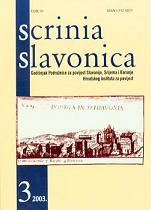Prilog proučavanju vinogradarstva na našičkom vlastelinstvu u prvoj polovici 18. stoljeća
Contribution to examining wine-growing in Nasice manorial estate in the first half of the 18th century
Author(s): Milan VrbanusSubject(s): History
Published by: Hrvatski institut za povijest
Keywords: Našice manorial domain; domain inventories; wine-growing; arable lands; tithe; wine; first half of the 18th century
Summary/Abstract: Wine growing is a field of economy which used to be an indicator of social conditions in a certain region. Namely, wine growing depends largely on the density of population in a certain region. Therefore, the decrease of wine-growing business is a clear sign that is has also come to the decrease of population on a certain manorial estate. It is not possible to determine the degree of processing of the vineyard on the Našice manorial estate for the years of 1703 and 1704. That is to say, manorial estate lists do not contain exact data od the size of arable land on which wine grape was grown. Slightly less than 2/3 of all vineyards were cultivated in 1721. Two years later the degree of processing increased to somewhat less then 3/4 of all arable land on which wine grape was grown. These facts show a slight increase of the degree of processing of the vineyard. However, this increase can be ascribed to the fact that the residents of Donja Motièina were not included in the census. As for the physical conditions of the Našice manorial estate, they were better in the valleys than the hill area. They must have presumed that the hill area was more suitable for wine growing than the plains. In 1703 approximately ten motikas (the area ploughed by a farmer in one day) of vineyard were cultivated in this area by the residents. The second half of the 18th century saw expansion of wine growing. Namely, before August 19, 1714 the size of the land on which wine grape was grown increased almost seven time. This expansion continued until the year of 1736. Still, the estate saw a slight decrease of the size of vineyards, which was caused by the exclusion of the village Donja Motièina from the census. After 1736, vineyards became considerably smaller. This condition was the result of the war between the Habsburg Monarchy and the Ottoman Empire and the plague epidemics on the territory of Slavonia. It is to be expected that after the war and the plague epidemics had ended the area of cultivated vineyards on the estate became to some extent larger. The Pejačević family took certain measures and focussed them on the strengthening of their estate economy, which was unquestionable an enormous contribution to it. There is no information on wine growing in the 18th century in the documents of the Našice estate. Yet, it is possible to determine the capacity of wine growing in this region on the basis of the lists showing the payment of the tithe. The amount of the tithe, that is to say, the production of wine can be continually trailed from 1701 to 1725 from 1729 to 1731 and finally for the year of 1746. The list showing the payment of the tithe show it clearly htat it had been increasing continuously from 1706 to 1722 (with slight oscillation), which leads to a conclusion that wine production had been increasing simultaneously. After this period, wine production started to decrease and increase only occasionally.
Journal: Scrinia Slavonica
- Issue Year: 2003
- Issue No: 3
- Page Range: 171-199
- Page Count: 29
- Language: Croatian

